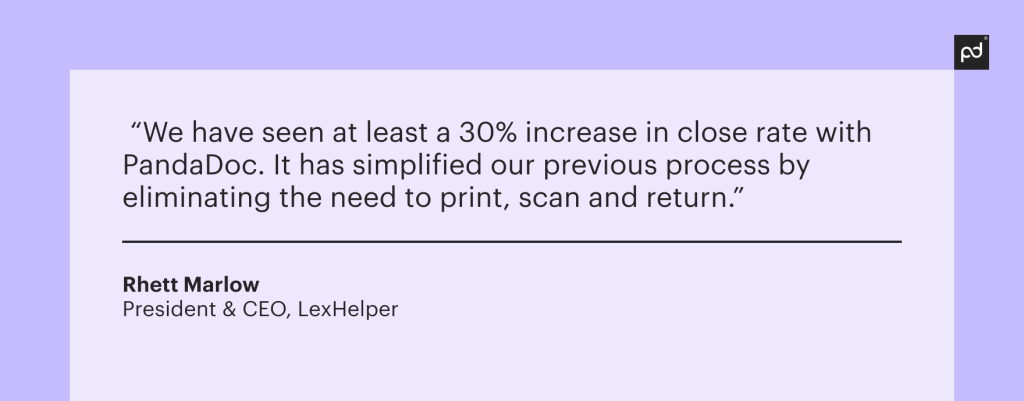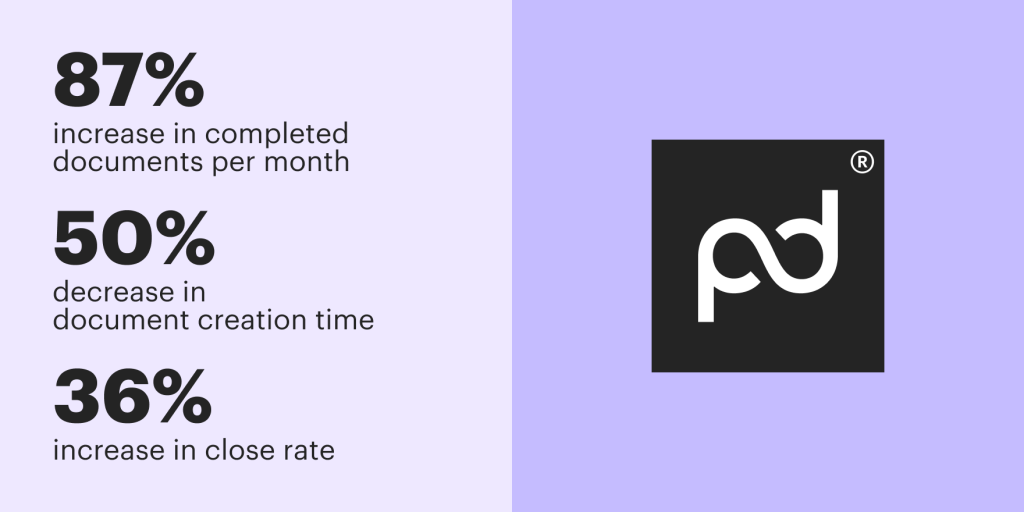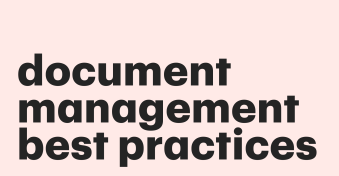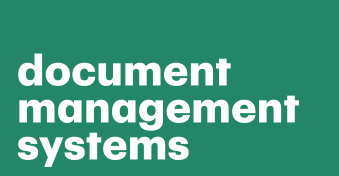Managing documents efficiently is critical for businesses to maintain organization, ensure compliance, and improve productivity.
Document management systems (DMS) simplify this process, offering tools for storing, retrieving, and collaborating on files.
Here’s a detailed guide to understanding and implementing effective document management strategies.
What is a document management system?
A DMS serves as a centralized repository for all document types, including digital and paper files. It offers features like:
Version control
Helps you keep accurate document tracking during collaborations.
Search capabilities
Quickly locate files with metadata and filters.
Workflow automation
Streamlines repetitive tasks like approvals and archiving.
Security measures
Protects sensitive data with encryption and role-based access.
More than 5,000 organizations, ranging from small businesses to enterprises, use DMS tools like PandaDoc to save time and improve operations.
Modern systems often incorporate artificial intelligence (AI) to categorize documents and recommend relevant templates to further improve workflow efficiency.
Who develops a document management strategy?
A document management strategy is typically led by IT, compliance, or records management teams, involving all necessary and vital parties across departments.
When more people are included, a management process is even more crucial for clarity and organization.
A well-developed document management strategy covers workflow processes for:
- Document creation and approval workflows.
- Security and permissions management.
- Retention schedules for archiving or disposing of documents.
For example, a pharmaceutical company might establish a strategy for regulatory compliance, so that all procedures are well documented, approved, and securely archived for audits.
Benefits of digital document management
Let’s cover some of the key benefits of having a digital document management system in place.
Enhanced collaboration
Cloud-based systems like PandaDoc enable real-time collaboration, allowing teams across locations to edit documents simultaneously.
A sales team in Chicago can update pricing sheets while the marketing team in Los Angeles reviews them, making cross-departmental communication efficient and easy.
Versatile file management
Digital systems support diverse file types, from text documents to multimedia files.
Organizations can centralize their operations, managing contracts, presentations, and videos within a single platform.
Access anywhere
With mobile optimization, employees can manage documents on-the-go.
Whether retrieving a file during a client meeting or approving a contract from a mobile device, DMS ensures flexibility without losing security.
Time savings
AI-powered search functions reduce the time spent digging your drives for documents. PandaDoc’s filters allow users to locate contracts by client name, date, or status in seconds.
That way when you’re in a hurry, a simple search of key words will pull up the document fast.
What are the steps of document management?
Let’s break down the best ways to put your new and improved document management system in place.
Upload documents
Gather documents from various sources and digitize paper files. Use automated import tools to quicken the process, pulling data directly from connected CRMs or cloud storage solutions.
Did you know PandaDoc syncs with your CRM like HubSpot, Salesforce, Pipedrive, and more?
Our integrations span payment gateways, CRMs, bookkeeping, communication apps, and many more. Request a free demo.

Organize and store
You can easily categorize files using metadata tags (client name, project type) and organize them into a matching folder structure.
As an example, a legal firm could group contracts by case type and stage (active, pending, closed).
Retrieve quickly
PandaDoc DMS has advanced search functionalities to locate files. Instead of digging through folders, a healthcare provider could use filters to find specific patient records while ensuring HIPAA compliance.
Review and update
Schedule regular audits to maintain document relevance. Collaborate with involved parties to update templates and remove outdated content.
DMS tools with version control prevent confusion by preserving a history of changes.
Secure data
Concerned about securing your documents? PandaDoc DMS has robust access controls and encryption to protect all your sensitive documents.
For example, a financial institution might restrict access to credit evaluations to specific employees, ensuring compliance with privacy regulations.
Dispose or archive
Establish retention schedules to identify documents for disposal or archiving. This minimizes clutter while preserving compliance.
For example, a company may securely destroy old employee records after seven years, following labor laws.
Emerging trends in document management
Let’s run through some trends we’re seeing across top industries when it comes to the utilization of document management.
AI integration
AI enhances document workflows by automating tasks like categorization, approval routing, and predictive content generation.
For instance, AI can suggest templates for contracts based on previous usage, saving time during document creation.
Mobile optimization
With remote work and many people needing access to documents anytime, anywhere, mobile-friendly DMS tools are vital in today’s market.
Employees can access, edit, and approve documents securely from their phones with flexibility.

Real-life example: document management in action
Let’s say you’re a real estate company. You’re in search of a new DMS and come across PandaDoc.
You try us out, and integrate our DMS with your CRM, automating workflows for property contracts.
Now:
- When a client submits an inquiry about a property, the system generates a customized agreement using pre-set templates.
- Team members collaborate in real-time, adding terms and conditions while ensuring compliance with local regulations.
- The document is routed for approval and sent for e-signature. Once signed, it’s automatically stored in a secure folder tagged with the property address and client name.
This end-to-end automation saves hours of admin work while minimizing the risk of human error, improving client satisfaction and operational efficiency. Win/win.

Key features of an effective DMS
Metadata and indexing
Metadata tags (e.g., keywords, dates) enhance searchability.
An indexed system provides users with a detailed overview of all stored documents, making search and retrieval easier.
Version control
Tracking changes let’s you search with confidence so you know that the most current version of a document is available, which is crucial for contracts or policies.
Integrations
Integrate PandaDoc easily with CRMs, accounting software, and other tools to cut down on redundant data entry.
For example, PandaDoc’s integration with Salesforce allows sales teams to populate contracts with client data directly.
Audit trails
Maintain transparency and compliance by tracking document activities, from creation to archiving.
Customizable workflows
Automated workflows tailored to specific needs help you know that documents follow the correct approval process.
Implementing a document management strategy
- Define Objectives: Identify goals, like reducing document retrieval times or improving compliance (or better, both!).
- Select a DMS: Choose a system that aligns with organizational needs such as scalability, integrations, and security. PandaDoc DMS covers it all, and then some.
- Train Employees: Provide training on folder structures, metadata tagging, and best practices to maintain consistency across departments for easier organization.
- Monitor and Adjust: Regularly review the system’s effectiveness and adjust methods as needed.
PandaDoc for all your DMS needs and more
Effective document management is about more than just organizing files — it’s about boosting collaboration, reducing errors, and improving overall efficiency within your organization.
By choosing to implement modern DMS tools and strategies, you can stay competitive in the market and cut down on admin tasks.
Whether you’re looking to update your system, or simply make things easier, PandaDoc DMS has what you need.
Start your free 14-day trial to find out.
Disclaimer
PandаDoc is not a law firm, or a substitute for an attorney or law firm. This page is not intended to and does not provide legal advice. Should you have legal questions on the validity of e-signatures or digital signatures and the enforceability thereof, please consult with an attorney or law firm. Use of PandaDocs services are governed by our Terms of Use and Privacy Policy.
Originally published September 12, 2024, updated December 6, 2024


